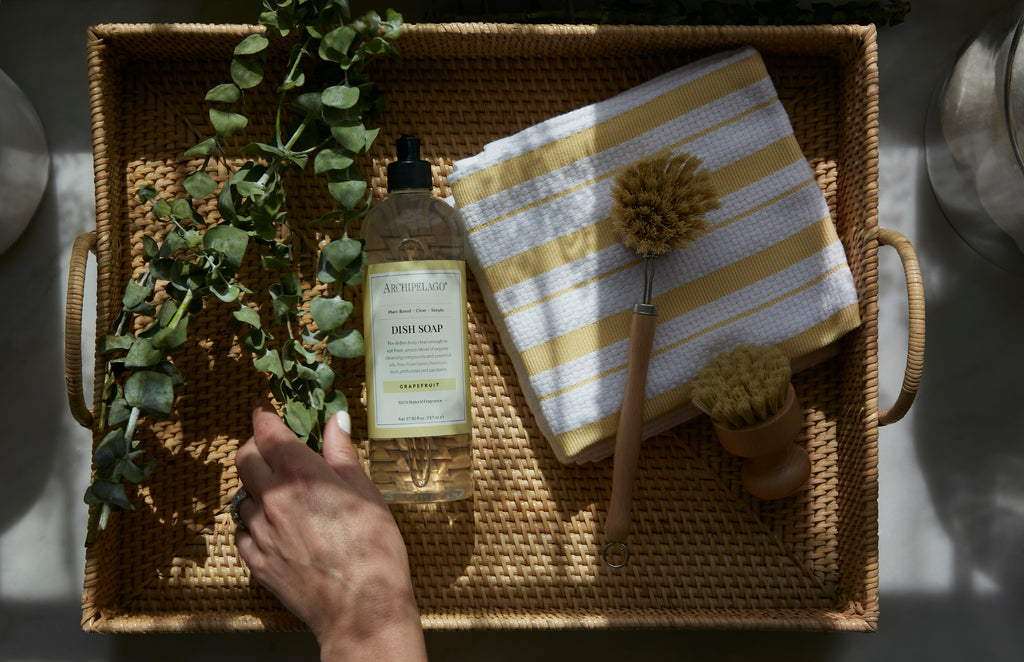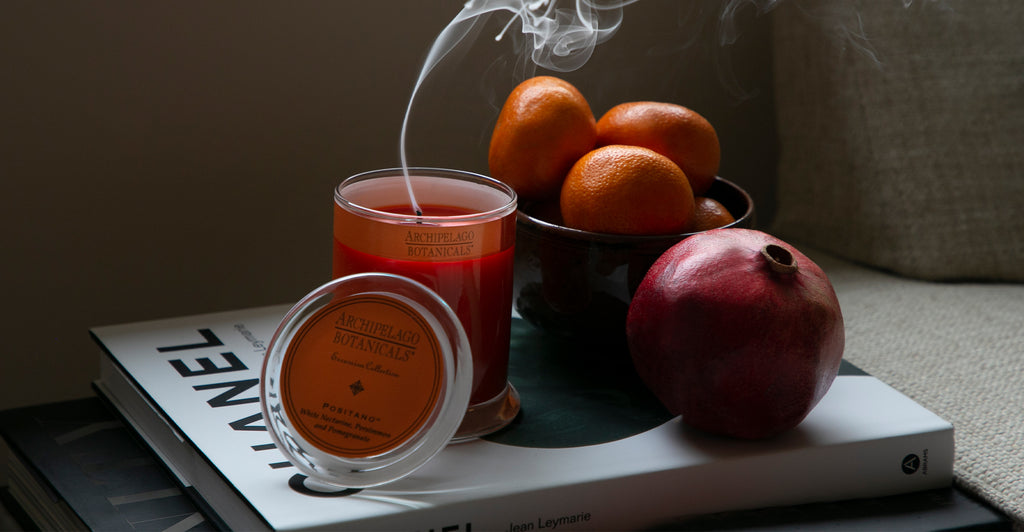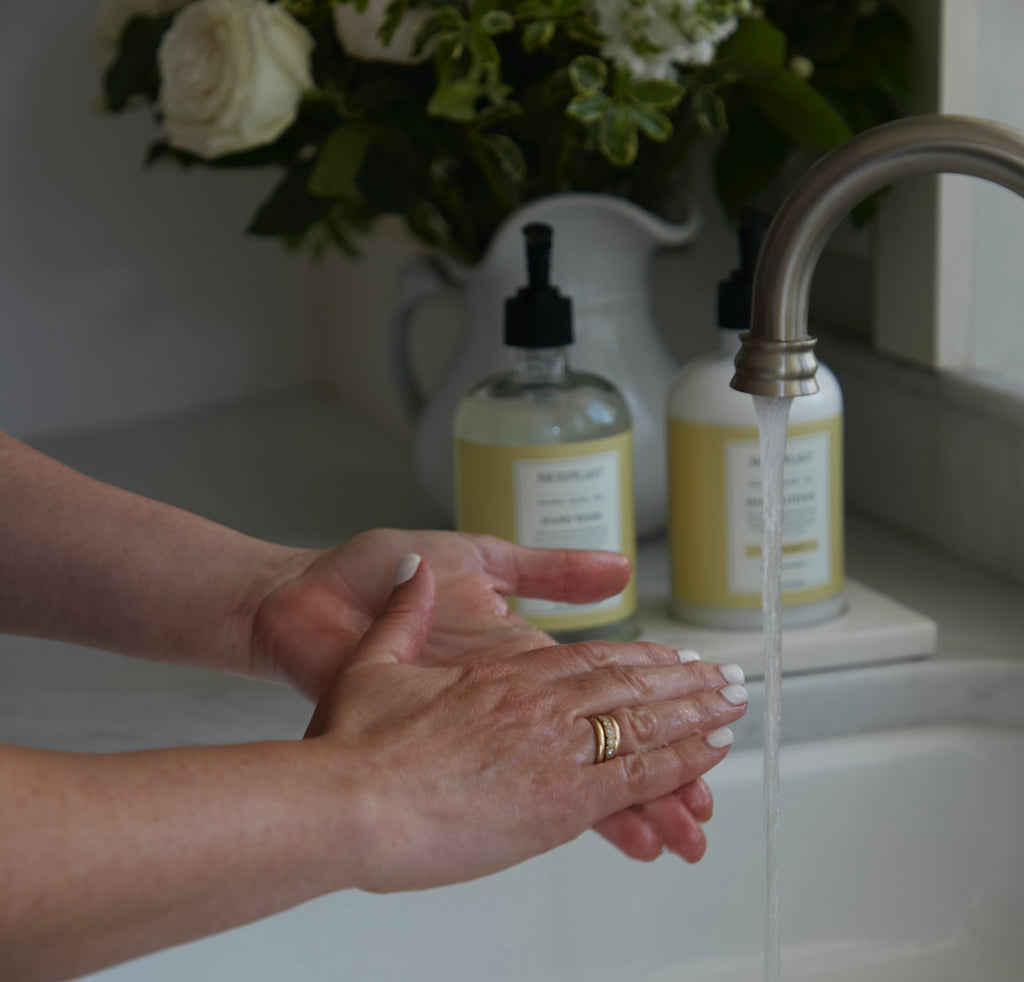How To Wash Dishes By Hand: A Simplified Guide
To load the dishwasher or to hand wash the boards, cheese knives, and jam jars left over from the charcuterie spread? That is, in our efficiency-seeking world, the question.
The truth is, washing your dishes by hand can not only clean your dishes more thoroughly, but it can also save on natural resources like energy and water. Plus, after a night of entertaining, the warm, sudsy water and peaceful solitude can refresh your glassware and your energy.
Let's discuss how to wash dishes by hand with care. We’ll show you eco-conscious and natural cleaning products to choose from as well as the steps on how to wash a dish to sparkling perfection.
What Products are Needed to Wash Dishes by Hand?
If hand washing dishes hasn’t historically been your favorite activity, you may be accustomed to a lackadaisical approach to the task. Only once there's a certain number of dirty mugs, pots, and plates in or around the kitchen sink do you jump into action—flicking on the faucet, grabbing the nearest sponge, and getting down to scrubbing-bubble business.
However, this method often leads to wasted water, energy, and elbow grease. Approaching your dishwashing with preparation and a stress-free mind will result in a more efficient process. And preparation—starts with gathering the right tools.
Invest in high-quality cleaning products for the best handwashing results:
- Dish soap – An obvious first item, dish soap is the backbone of your dishwashing suds. Select a natural dish soap, such as Archipelago’s Natural Dish Soap, that’ll cut through grease and oil without harming the water, your skin, or your dishware with harsh chemicals. If you’re out of your trusty dish soap and dread refilling the bottle, you’ll want to take the extra step to do so rather than reaching for, say, the hand soap nearby. This is because there are quite a few differences between dish soap vs hand soap, and it’s important to stick to dish soap when cleaning your plateware, glassware, silverware, and so on.
- Sponges – A scrubbing essential, nonabrasive sponges are best for cleaning nonstick items and your delicate dishware. Remember to switch out your sponges every two weeks to avoid bacteria buildup.1
- Scouring Pads/Steel Wool – Scrubbing tools with a rougher texture make tough-to-clean dishes a breeze. Remember to check your dishes first to make sure they won’t be damaged by abrasive textures.
- Brushes – Long or short, having a bristly dish brush in your toolkit will make cleaning your Nalgenes, Hydro flasks, and reusable metal straws faster and easier.
- Drying rack – Investing in a durable, spacious drying rack will make your overall dishwashing more efficient, as you’ll have a dedicated space to allow your rinsed-off dishes to air dry. Place a dish-drying towel or stone underneath to absorb excess moisture.
- Hand towels – In lieu of using a drying rack and to avoid hard-water stains on glass or metal, use a hand towel to dry your dishes. Paper towels are also efficient for this, although they’re less environmentally friendly (and won’t match your potholders).
- Rubber gloves – Dish soap is notorious for drying out hands thanks to its oil-stripping abilities. To avoid cracked knuckles and painful palms, especially during colder, drier months, use a pair of rubber gloves to protect your skin. This is especially important if you’re unsure of the dish soap ingredients in your current go-to product, as some can be too harsh on the skin.
- Plastic tub – Spoiler alert: The best way to hand wash dishes involves a two-basin sink, but if you don’t have a kitchen sink with two basins, you can utilize a plastic tub or bucket. Make sure it’s big enough for a cumbersome pot or pan to be fully immersed if the bucket or tub is filled with water. This method will not only help you efficiently hand wash dishes, but also help save excess running water.
Now that we’ve covered the essential items you’ll need for efficient hand dishwashing, let’s review the best way to wash your dishes by hand.
How to Properly Wash Dishes by Hand: Step-By-Step
We’ll start embarking on how to hand wash dishes by preparing the area where we’ll be cleaning our dishes. This can entail putting your dirty dishes in a dirty dish tub so that they’re:
- In one, concentrated space, and
- Out of the sink.
To achieve maximum sanitization, we recommend cleaning your sink first. Making sure to wipe down the basin, faucet handles, and faucet, you can clean your sink with vinegar, a natural cleaner like our Natural Disinfectant Spray, and a cleaning cloth.2
Step One: Scrape Food
If you haven’t already done this, scrape off any remaining debris on your dishes. You can do this with a spatula, food scraper, or a paper towel, all non-abrasive items that should be safe to use against delicate dishware.
By thoroughly wiping food from your dishes, you cut down on the amount of time spent scrubbing at the sink. Dump the leftover food into the garbage, your garbage disposal, or your compost bin.
Note: Refrain from pouring grease down your garbage disposal as it will solidify and clog.3
Step Two: Fill Sinks
As we’ve already teased, the two-basin method is arguably the most efficient way to wash dishes by hand. If your kitchen is sporting a spacious two-basin sink, prepare them the following ways:
- Basin one – In the basin closest to your dirty dishes, fill it with hot water (if you have rubber gloves to protect your skin, you can make the water slightly hotter) and a few jets of dish soap. This basin of hot soapy water will be your scrubbing basin.1
- Basin two – Fill the second basin with cool, clean water, about halfway up. This will be your rinsing basin, which you’ll most likely refill once or twice with fresh water as it becomes soapy, depending on how many dishes you’re washing.
If you don’t have a two-basin sink set up, fill your sink with hot water, and use a plastic tub or bucket (as mentioned above) to hold the cool water you’ll be using for the rinsing stage.
Step Three: Soak Dishes in Hot Water and Scrub Clean
The next step is to soak your dishes. This will help loosen any stuck-on food you weren’t able to scrape off. Soaking should last between 15 and 30 minutes—plenty of time to light a candle, pour a glass of wine, or catch an episode of Below Deck.
Note: Remember to check to make sure your dishware can be soaked. Some dishes, like cast iron skillets, may rust or become otherwise damaged when hand-washed. For those, you can skip the soak and run them under the faucet instead.
Once 15 to 30 minutes have passed, take up your appropriate scrubbing tool (a sponge, scouring pad, or brush). It’s best to start with the smaller items first and work your way up to pots, pans, and dirtier items. Processing your dishes in this manner will help reduce the amount of cool, rinsing water you’ll have to replace once it gets too soapy.
Step Four: Submerge Dishes in Clean Water to Remove Suds
Once your dishes have been freshly scrubbed clean, dip them in your second basin or cool-water tub. This is intended to remove the soap build-up, so continue dipping and rinsing until the dishes no longer feel soapy. If they still feel greasy, it may be a good idea to give them another scrub and rinse.
If you want to ensure thorough sanitization, spray the rinsed dishes down with a flume of hot water. The temperature will help kill any remaining germs or bacteria.
Step Five: Place Dishes on a Drying Rack
The last (and most triumphant) step is to dry your sparkly-clean dishes. After you’ve thoroughly rinsed each dish, place on your drying rack to drain any excess water, making sure to leave room between dishes for air to circulate. Place a dish towel underneath the drying rack to catch any dripping water.
As mentioned above, if you’re cleaning metal or glass, you can avoid any spotting, filming, or rusting by drying the dish immediately with a hand towel or paper towel.
Once you’re done cleaning all of the dishes, make sure to wipe down the dirty dish basin, the sink, and the drying rack. Any rags, sponges, or brushes you used should be left out to air dry or thrown in the laundry.
Ways to Make Hand-Washing Dishes More Efficient
While the above process is one of the most efficient ways to hand-wash your dishes, there are even more tips you can explore and perfect as you hone your newfound craft.
Here are some tips for making your dishwashing more leisurely than ever:
- Double (or triple) up rinsing – When you’re washing the suds off your scrubbed dishes, don’t be afraid to rinse multiple dishes at once, especially flatware and utensils. Your rinsing won’t be impacted, and you’ll speed up your washing.
- Use vinegar for water spots – If you’ve been hand drying your dishes and you’re still seeing residue from hard water, try adding one cup of vinegar to your rinse water. This will help break down any mineral deposits left on your dishes.4
- Try cleaning with cold water – While not efficient for every food stain, cleaning your dishes with cold water is best when trying to remove dairy or starches from dishes. Hot water can cause these substances to gum up and leave stains.5
- Use an oven for extra drying space – If you’ve reached the limits of your drying rack’s space, use your oven. Just make sure it’s decently cleaned so that you don’t end up needing to wash them again.
- Scrub grease with salt – Naturally abrasive and absorbent, salt is perfect for removing grease from pots and pans with a dry sponge.6
Enjoy a Naturally Clean Home with Archipelago
In our opinion, washing dishes by hand is much more than a chore: it’s an art form. There are few things more satisfying than getting your Waterford glass tumblers to shine as bright as the first time you used them.
When you surround yourself with a clean space, you can live a more stress-free, luxurious life. And the cleanest spaces are those cleaned with chemical-free products powered by natural plants and fragrant ingredients.
To achieve a naturally clean home—from your dishware to your laundry room—tap into the natural cleaning products from Archipelago. Our dish soap, hand lotion, cleaning spray, and laundry detergent features plant-powered bio-formulas and essential oils designed for a powerful clean and indulgent fragrance of sophistication and rejuvenation.
Sources:
- New York Times. How to Hand Wash Dishes Better. https://www.nytimes.com/wirecutter/guides/how-to-hand-wash-dishes/
- Home Warranty of America. How to Disinfect and Keep Your Kitchen Clean. https://www.hwahomewarranty.com/learning-center/homeowners/home-maintenance/clean-and-disinfect-kitchen-sink
- Insider. Here's The Terrible Thing That Happens When You Pour Grease Down The Drain. https://www.businessinsider.com/why-cant-you-pour-grease-down-the-drain-2014-8
- The Spruce. How to Remove Hard Water Stains From Glass. https://www.thespruce.com/how-to-remove-hard-water-stains-from-glass-5199450
- Cleanipedia. How to wash dishes by hand. https://www.cleanipedia.com/za/kitchen-cleaning/wash-dishes-by-hand.html
- Real Homes. How to clean a burnt pan quickly with salt, baking soda, vinegar and more. https://www.realhomes.com/news/how-to-clean-a-burnt-pan
Featured in this article:









